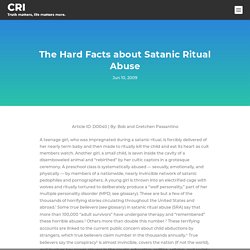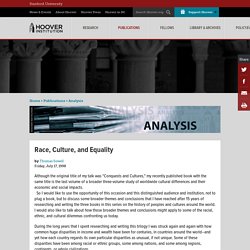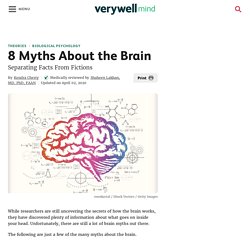

The Power of Human Resilience. Long time readers of this blog have been kept abreast of the latest research into psychological resilience.

Link here. The studies, which are proliferating, suggest that most trauma victims resolve their suffering without undergoing therapy. The Hard Facts about Satanic Ritual Abuse. Article ID: DO040 | By: Bob and Gretchen Passantino A teenage girl, who was impregnated during a satanic ritual, is forcibly delivered of her nearly term baby and then made to ritually kill the child and eat its heart as cult members watch.

Another girl, a small child, is sewn inside the cavity of a disemboweled animal and “rebirthed” by her cultic captors in a grotesque ceremony. A preschool class is systematically abused — sexually, emotionally, and physically — by members of a nationwide, nearly invincible network of satanic pedophiles and pornographers. A young girl is thrown into an electrified cage with wolves and ritually tortured to deliberately produce a “wolf personality,” part of her multiple personality disorder (MPD; see glossary). Typical SRA stories display certain essential elements that remain uniform whether the story is “discovered” by a therapist, a social worker, or a parent, and whether the victim is an adult or a child.
John P.A. Ioannidis: Scientific petitions and open letters in the covid-19 era. Scientific truth should not be decided by the bulk of signatories, argues John Ioannidis Petitions and open letters signed by large numbers of scientists are not new, but they have proliferated in the covid-19 era. [1,2] They have a clear role when it comes to questions of ethics, social problems, and injustices.

With monumental consequences from both the pandemic and the response to the pandemic, debating ethical and social issues is the right of every citizen, including scientists. A collateral damage, however, is when these documents are aimed to prove or disprove scientific positions. Scientists may take pride that their advocacy can save lives, mobilize resources for worthy enterprises, or teach leaders and fellow citizens. Petitions often convey a sense of urgency, conviction, and resolution. Don’t Defend Columbus—Celebrate Him. After a summer of assaults on Christopher Columbus’s legacy, it’s a small miracle that Columbus Day is still hanging on as a federal holiday.

Columbus has been under attack since at least 1980, when Howard Zinn vilified him in his anti-American polemic A People’s History of the United States. More recently, Columbus’s reputation has come under attack like never before. Smarter than ever? Over the past 100 years, Americans' mean IQ has been on a slow but steady climb.

Between 1900 and 2012, it rose nearly 30 points, which means that the average person of 2012 had a higher IQ than 95 percent of the population had in 1900. Political scientist James Flynn, PhD, of the University of Otago in New Zealand, first discovered those astonishing IQ gains nearly 30 years ago. Race, Culture, and Equality. Although the original title of my talk was "Conquests and Cultures," my recently published book with the same title is the last volume of a broader three-volume study of worldwide cultural differences and their economic and social impacts.1 So I would like to use the opportunity of this occasion and this distinguished audience and institution, not to plug a book, but to discuss some broader themes and conclusions that I have reached after 15 years of researching and writing the three books in this series on the history of peoples and cultures around the world.

I would also like to talk about how those broader themes and conclusions might apply to some of the racial, ethnic, and cultural dilemmas confronting us today. In the nineteenth century, real per capita income in the Balkans was about one-third that in Britain. Pretending that Intelligence Doesn’t Matter. The first public broadside against the new field of intelligence research was struck in 1922 by the journalist Walter Lippmann, who criticized the swelling cadre of IQ-test enthusiasts for “pretentious” claims, “abuse of scientific method,” and a “New Snobbery.”1 In intervening decades, thousands of scientists have entered the field, some bent on testing the claims that they initially thought dubious.

Representing disciplines from genetics to sociology, these scientists have produced a vast body of evidence about why people differ in intelligence, how durable those differences are, and what they mean for us as individuals and as a society. As befits a vibrant, interdisciplinary endeavor, the field’s scientists scarcely agree on all matters, but they have forged a consensus on certain fundamental facts—on the ABC’s, so to speak. Their conclusion is that differences in general intelligence are real, stubborn, and important. Was George W. Bush as dumb as the media portrayed him? George W. Bush is smarter than you - Keith Hennessey. The new George W.

Bush Presidential Center is being dedicated this week. This seems like a good time to bust a longstanding myth about our former President, my former boss. I teach a class at Stanford Business School titled “Financial Crises in the U.S. and Europe.” How Government “Cures” Drive Out Real Cures – AIER. Barry Brownstein – August 11, 2020 Scurvy, we all know, is a disease caused by a vitamin C deficiency.

It took almost 200 years from the time a “lemon juice” cure for scurvy was discovered until it was promoted by the British government. (340) Astronaut Chris Hadfield Debunks Space Myths. Debunking 8 Popular Myths About the Brain. While researchers are still uncovering the secrets of how the brain works, they have discovered plenty of information about what goes on inside your head.

Unfortunately, there are still a lot of brain myths out there. The following are just a few of the many myths about the brain. Reexamining the Mythology of the Tarahumara Runners. You remember the Tarahumara, right? They are, as Christopher McDougall memorably described them in Born to Run back in 2009, the “near-mythical tribe of Stone Age superathletes” who live in the canyons of northwestern Mexico and run astounding distances over vertiginous terrain without even breaking a sweat. Born to Run also introduced the wider world to a Harvard anthropologist and evolutionary biologist named Daniel Lieberman, whose research on the evolutionary origins of running led him to hypothesize that even modern humans would be better off running either barefoot or with minimally supportive shoes. Colorful tales of the Tarahumara mixed with Lieberman’s scientific cred made for a potent combination, and interest in barefoot and minimalist running exploded after the publication of McDougall’s book.
When did we start believing in Martians? Why did we stop? Today, we have rovers busily studying the surface of Mars, but 100 years ago, it wasn't uncommon for people to believe that intelligent Martians occupied the Red Planet, and 100 years before that, visions of Moon dwellers danced in many people's heads. Where did these ideas of nearby intelligent extraterrestrials come from? And why did we stop believing in them? Top image by JD Hancock. Christopher Columbus Never Set Out to Prove the Earth was Round. In 1492, Christopher Columbus was shocked when his ship made landfall in a land Europeans had never explored. Along the way, he proved that Earth isn’t flat after all. Right? Wrong: Despite a persistent legend, neither Columbus nor his Spanish patrons thought Earth was a finite plane instead of a round planet. And you can blame one of the United States’ greatest authors for creating a myth that still surrounds one of history’s best-known figures.
Satanic abuse, false memories, weird beliefs and moral panics. Conviction of Things Not Seen: The Uniquely American Myth of Satanic Cults. Jim Jones and David Koresh are among the small handful of men who remain even more infamous than the cults they led. Not every middle-aged American will remember the People’s Temple of the Disciples of Christ, but most know who Jones was. The Branch Davidians might not be a familiar name, even to those who remember the siege that claimed the lives of 76 of Koresh’s adherents—but his name, and that of Waco, Texas, survive in infamy. (The fate of Jones’ doomed commune is so widely known that the figure of speech “drinking the Kool-Aid,” a phrase describing the liquid poisoning of more than 900 people, has become a fixture in everyday discourse—a casual and rather sickening disavowal of the scale of the tragedy that unfolded at Jonestown.)
Satanism lacks a Jones or Koresh. Satanism has no Jonestown, no Waco, no Kool-Aid, no casual point of reference.